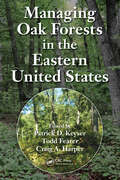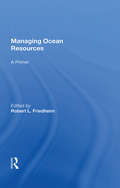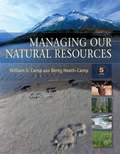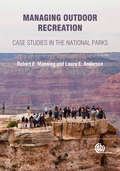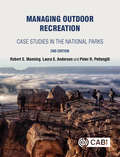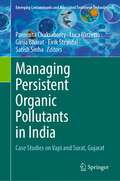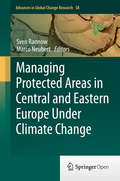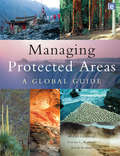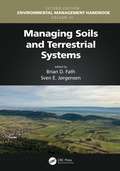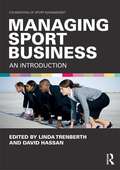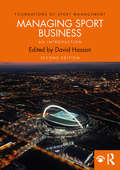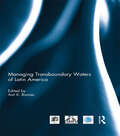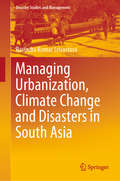- Table View
- List View
Managing Oak Forests in the Eastern United States
by Patrick D. Keyser Todd Fearer Craig A. HarperIf you are responsible for oak management, Managing Oak Forests in the Eastern United States is for you. It is the definitive practical guide for anyone interested in improving stewardship of eastern oak forests. Organized into three sections, the first section, "Background and Biology: Setting the Stage," helps you establish a solid understanding
Managing Ocean Resources: a Primer
by Robert L FriedheimThis comprehensive collection of data and theory provides an essential resource base for intelligent ocean-management decisions. The book begins with essays on ocean science and technology, social and political organization theory relating to the oceans, and some of the problems of extracting energy from the oceans and monitoring oceans from space.
Managing Oil Wealth: The Case of Azerbaijan
by Eric Le Borgne Stephan Danninger John Wakeman-Linn Chonira Aturupane Koba Gvenetadze Niko HobdariOil and gas production in Azerbaijan are projected to increase sharply in 2005 and 2006, respectively, reaching peaks of 1. 3 million barrels per day in 2009 and 20 billion cubic meters per year in 2010. Although expected revenues over the next 20 years will be substantial, they are projected to return to 2004 levels by 2024. Managing this temporary windfall in a way that allows for economic diversification and increased living standards is the subject of this book, which provides extensive guidance based largely on lessons drawn from the experiences-mostly negative-of other countries.
Managing Our Natural Resources
by Betty Heath-Camp William G. CampNew edition of a text that presents a balanced viewpoint of the place of humans in the world as long-term residents. Camp (Virginia Polytechnic Institute and State U.) and Daugherty (Maconaquah High School) present 35 chapters that deal with soil formation, erosion, reclamation, and conservation; water use and improvement; endangered species of wildlife; hunting game animals; fishing; safety in boating, hiking, and other forms of outdoor recreation; conservation farming; land-use planning; construction practices that minimize the impact of exploitation on the environment; energy resources use, abuse, conservation, and alternatives; mineral use and recycling; and career opportunities in each of those diverse fields. Contains b&w illustrations. Annotation c. Book News, Inc., Portland, OR (booknews.com)
Managing Outdoor Recreation
by Laura E Anderson Robert E ManningThe popularity of outdoor recreation and ecotourism continues to grow worldwide. However, there is little systematic information on how to manage outdoor recreation in ways that protect park resources and the quality of the visitor experience. This book develops classification systems of outdoor recreation-related problems and management strategies and practices and combines them into a series of matrices that can help guide park and outdoor recreation management. The book then uses a series of case studies drawn from the U.S. National Park System that illustrate a range of successful management approaches that can be applied globally. The book concludes with a series of principles for managing parks and outdoor recreation.
Managing Outdoor Recreation: Case Studies in the National Parks
by Robert Manning Laura E Anderson Peter PettengillThis fully updated second edition presents a conceptual framework of outdoor recreation management in the form of a series of management matrices. It then illustrates this framework through new and updated case studies in the US national parks, and concludes with the principles of outdoor recreation management. Written by an author team with extensive academic and practical experience in the field of outdoor recreation, the book: - Develops and presents a matrix-based framework of strategies and practices for managing outdoor recreation in a sustainable way. - Illustrates application of best management practices through a series of case studies in diverse national parks. - Includes lecture slides and online matrices to aid the teaching of outdoor recreation management to a new generation. Managing Outdoor Recreation, 2nd Edition is an essential resource for undergraduate and graduate students of parks, outdoor recreation and related subjects, as well as a helpful tool for practitioners.
Managing Persistent Organic Pollutants in India: Case Studies on Vapi and Surat, Gujarat (Emerging Contaminants and Associated Treatment Technologies)
by Paromita Chakraborty Luca Nizzetto Girija Bharat Eirik Steindal Satish SinhaPersistent Organic Pollutants (POPs) are a class of chemicals that are persistent, bio accumulative and toxic (PBT), which are restricted for use under the Stockholm Convention. They adversely impact the environment, human and animal health. Most of the POPs are semi-volatile organic compounds (SVOCs) and known to have a long-range transport potential and are often deposited in colder climate and found in places away from the regions they are produced. POPs are usually hydrophobic (i.e., “water-hating”) and lipophilic (i.e., “fat-loving”) chemicals, due to which they bind to solids, particularly organic matter, and fatty tissues in both marine and terrestrial environments. As a result, POPs may move up the food chain. This book focuses on determining the sources, fate, analytical techniques of detecting POPs as well as their health impacts. It further dwells on the regulatory aspects, management of POPs, best environmental practices (BEPs), Indian and international case studies, gaps in understanding the regulatory aspects. A few key recommendations for the way forward form the concluding chapters of this book.
Managing Protected Areas in Central and Eastern Europe Under Climate Change
by Sven Rannow Marco NeubertBeginning with an overview of data and concepts developed in the EU-project HABIT-CHANGE, this book addresses the need for sharing knowledge and experience in the field of biodiversity conservation and climate change. There is an urgent need to build capacity in protected areas to monitor, assess, manage and report the effects of climate change and their interaction with other pressures. The contributors identify barriers to the adaptation of conservation management, such as the mismatch between planning reality and the decision context at site level. Short and vivid descriptions of case studies, drawn from investigation areas all over Central and Eastern Europe, illustrate both the local impacts of climate change and their consequences for future management. These focus on ecosystems most vulnerable to changes in climatic conditions, including alpine areas, wetlands, forests, lowland grasslands and coastal areas. The case studies demonstrate the application of adaptation strategies in protected areas like National Parks, Biosphere Reserves and Natural Parks, and reflect the potential benefits as well as existing obstacles. A general section provides the necessary background information on climate trends and their effects on abiotic and biotic components. Often, the parties to policy change and conservation management, including managers, land users and stakeholders, lack both expertise and incentives to undertake adaptation activities. The authors recognise that achieving the needed changes in behavior - habit - is as much a social learning process as a matter of science-based procedure. They describe the implementation of modeling, impact assessment and monitoring of climate conditions, and show how the results can support efforts to increase stakeholder involvement in local adaptation strategies. The book concludes by pointing out the need for more work to communicate the cross-sectoral nature of biodiversity protection, the value of well-informed planning in the long-term process of adaptation, the definition of acceptable change, and the motivational value of exchanging experience and examples of good practice.
Managing Protected Areas: A Global Guide
by Michael Lockwood Ashish Kothari Graeme L. WorboysThis handbook, produced by world renowned experts from the World Conservation Union (IUCN), spans the full terrain of protected area management and is the international benchmark for the field. The book employs dozens of detailed international cases studies, hundreds of concise topical snapshots, maps, tables, illustrations and a colour plate section, as well as evaluation tools, checklists and numerous appendices to cover all aspects of park management from biodiversity to natural heritage to financial management. The book establishes a conceptual underpinning for protected area management, presents guiding principles for the 21st century, reflects recent work on international best practice and provides an assessment of skills required by professionals. As the most authoritative guide ever compiled to the principles and practice of protected area management, this volume is essential for all professionals and students in all countries and contexts.
Managing Protected Areas: People and Places
by Richard Clarke Niall Finneran Denise HewlettThis open access book brings together 16 specially commissioned chapters drawn from a range of different professional-practitioner and academic global perspectives on the importance of the relationship between people and green and blue spaces. It focuses on issues surrounding the importance of natural environments on public health and wellbeing, and the environmental, cultural, and social importance of green and blue spaces that can result through responsible and sustainable adaptive management processes. It explores how the Covid-19 pandemic forced reconsiderations of our relationship with these natural spaces and highlights the important impact of the pace of climate change. While not pretending to have the answers, the stimulating and imaginative contributions embrace rich perspectives drawn from backgrounds as diverse as heritage studies, tourism, conservation, geography, policy formulation, public health, environmental health, research methods, history, literature, art, and theology.
Managing Soils and Terrestrial Systems
by Brian D. Fath Sven E. JørgensenBringing together a wealth of knowledge, Environmental Management Handbook, Second Edition, gives a comprehensive overview of environmental problems, their sources, their assessment, and their solutions. Through in-depth entries and a topical table of contents, readers will quickly find answers to questions about environmental problems and their corresponding management issues. This six-volume set is a reimagining of the award-winning Encyclopedia of Environmental Management, published in 2013, and features insights from more than 400 contributors, all experts in their field. The experience, evidence, methods, and models used in studying environmental management are presented here in six stand-alone volumes, arranged along the major environmental systems. Features The first handbook that demonstrates the key processes and provisions for enhancing environmental management Addresses new and cutting-edge topics on ecosystem services, resilience, sustainability, food–energy–water nexus, socio-ecological systems, and more Provides an excellent basic knowledge on environmental systems, explains how these systems function, and offers strategies on how to best manage them Includes the most important problems and solutions facing environmental management today In this third volume, Managing Soils and Terrestrial Systems, the general concepts and processes of the geosphere with its related soil and terrestrial systems are introduced. It explains how these systems function and provides strategies on how to best manage them. It serves as an excellent resource for finding basic knowledge on the geosphere systems and includes important problems and solutions that environmental managers face today. This book practically demonstrates the key processes, methods, and models used in studying environmental management.
Managing Sport Business: An Introduction
by David HassanContemporary sport is both a sophisticated and complex international business and a mass participatory practice run largely by volunteers and community organizations. This authoritative and comprehensive introduction to the theory and practice of sports management helps to explain the modern commercial environment that shapes sport at all levels and gives clear and sensible guidance on best practice in sports management, from elite sport to the local level. The book is divided into three sections. The first examines the global context for contemporary sports management. The second explores the key functional areas of management, from organization and strategy to finance and marketing, and explains how successful managerial techniques can be applied in a sporting context. The final section surveys a wide range of important issues in contemporary sports management, from corporate social responsibility to the use of information and communication technologies. Together, these sections provide a complete package of theory, applied practical skills and a state-of-the-art review of modern sport business. With useful features included throughout, such as chapter summaries and definitions of key terms, and with each chapter supported with real-world data and examples, this book is essential reading for all students of sport management and sport business.
Managing Sport Business: An Introduction (Foundations of Sport Management)
by David HassanContemporary sport is both a sophisticated and complex international business and a mass participatory practice run largely by volunteers and community organisations. Now in a fully revised and expanded second edition, this authoritative and comprehensive introduction to the theory and practice of sports management helps to explain the modern commercial environment that shapes sport at all levels and gives clear and sensible guidance on best practice in sports management, from elite sport to the local level. The first section examines the global context for contemporary sports management. The second explores the key functional areas of management, from organisation and strategy to finance and marketing, and explains how successful managerial techniques can be applied in a sporting context. The final section surveys a wide range of important issues in contemporary sports management, from corporate social responsibility to the use of information and communication technologies. Together, these sections provide a complete package of theory, applied practical skills and a state-of-the-art review of modern sport business. Complemented by a companion website full of additional resources, this book is essential reading for all students of sport management and sport business.
Managing Transboundary Waters of Latin America (Routledge Special Issues on Water Policy and Governance)
by Asit K. BiswasDefinitive analyses of transboundary water management in Latin America are conspicuous by their absence. The situation is a little better for rivers compared to groundwater resources. Transboundary water management in Latin America has been evolving in a somewhat different manner compared to other continents.The book includes eight authoritative case studies of Latin American transboundary rivers and aquifers, as well as a thinkpiece on the complexities of managing aquifers based on global experiences. The case studies are of different scales, ranging from the mighty Amazon to small Silala. The overall focus of the book is on ways in which such difficult and complex rivers and aquifers that are shared by two or more countries can be managed efficiently and equitably, and on the lessons, both positive and negative, that other regions can learn from the Latin American experience.This book was published as a special issue of the International Journal of Water Resources Development.
Managing Urbanization, Climate Change and Disasters in South Asia (Disaster Studies and Management)
by Ravindra Kumar SrivastavaThis book offers essential insights into potential catastrophic events that might befall upon the emerging urban landscape in South Asia, and which are due to hazards, risks and vulnerabilities inherent in the region’s geophysical location, as well as due to climate change and unplanned urbanization. It highlights major physio-graphic, demographic, geological and geophysical indicators that are responsible for changing the pattern and trend of urbanization in South Asia – a crucial issue in view of emerging threats of climate change, and changes in the demographic profile. The book addresses the disaster management scenario in South Asia, manifestations of climate change in the region and various urban setups under climate-change-induced risks. Further, it elaborates on the challenges of urbanization-based neo-risks and vulnerabilities, which manifest in the form of slum area growth, piling and littering of waste and filth, new health risks, groundwater contamination, air pollution, highly energy-dependent lifestyles, poverty, socio-economic tensions, etc. It also critically examines the institutional mechanisms for disaster risk reduction (DRR), climate change adaptation (CCA) and urban governance, and suggests appropriate changes in the governing structure to mitigate these risks. The book draws the attention of urban planners and policymakers to current shortcomings in the administrative and financial structures of local urban bodies. While outlining climate-associated risks and adaptation strategies in South Asia, it also suggests measures for integrating climate change and urban adaption with state's planning processes, and puts forward a risk alleviation platform to bring the risk managers working in different fields together, so that they make concerted efforts to achieve sustainable development. It offers valuable takeaways for researchers, urban planners, those working in industry, consultants, and policymakers.
Managing Visitor Experiences in Nature-based Tourism
by Haywantee Ramkissoon Brent Lovelock Mary E. Allen Robert C. Burns Azizul Hassan Peter Fredman Ali Thompson Mick Abbott Karl Agius George Ariya Rocío Blanco-Gregory Cameron Boyle Kadir Çakar Eugenio Conti Fernando Enseñat-Soberanis Sonia Ferrari Stuart Hayes Nicolaia Iaffaldano Woody Lee Tiago Lopes Andrés Ried Luci Lusine Margaryan Johnathan Mondragón-Mejía Ana Goytia Prat Francisco Silva Jeffrey C. Skibins Ismail UzutThis book focuses on the experiences of tourists visiting nature-based destinations, exploring current knowledge and providing insights into conceptual issues through the use of empirical evidence from five continents. Presented as three topics, the contents discuss tourism and nature-based experiences by looking at the role and relevance of nature and the uniqueness of such experiences. The book identifies visitor management challenges and provides explanations for the solutions reached. The final section takes a more overarching destination management perspective that transcends the tourism product or business level and focuses on destination and generic issues like indicators or marketing implications. The book also includes research-based case studies which contribute to an overall understanding of the core issues involved in managing visitor experiences in nature-based tourism.
Managing Voluntary Sport Organizations
by Leigh RobinsonContemporary sport could not function without the involvement of voluntary organizations, from local grass-roots clubs to international agencies such as the International Olympic Committee. Management of this sector continues to undergo profound change, largely in response to the challenges of professionalization and increasing expectations in terms of transparency, accountability and ethical behaviour. This book fills a significant gap in the literature on sport management by setting out the principles and practices necessary for effective management of voluntary sport organizations around the world. In addition to applying and adapting established management strategies and techniques to voluntary sport organizations, this book is the first to fully relate mainstream organizational theory to this important sector of sport management. With contributions from an international team of researchers and management practitioners, the book explores key functional areas such as: governance strategy and planning human resources finance managing change marketing event management risk management. Each chapter discusses best practice and includes case study material, self test questions and guides to further reading. As the only book to outline a professional, theoretically informed and practically focused curriculum for voluntary sport management, this book is essential reading for all students of sport management and all managers working in or alongside the voluntary sector.
Managing Water Resources and Hydrological Systems
by Brian D. Fath Sven E. JørgensenBringing together a wealth of knowledge, Environmental Management Handbook, Second Edition, gives a comprehensive overview of environmental problems, their sources, their assessment, and their solutions. Through in-depth entries and a topical table of contents, readers will quickly find answers to questions about environmental problems and their corresponding management issues. This six-volume set is a reimagining of the award-winning Encyclopedia of Environmental Management, published in 2013, and features insights from more than 400 contributors, all experts in their field. The experience, evidence, methods, and models used in studying environmental management are presented here in six stand-alone volumes, arranged along the major environmental systems. Features The first handbook that demonstrates the key processes and provisions for enhancing environmental management Addresses new and cutting-edge topics on ecosystem services, resilience, sustainability, food–energy–water nexus, socio-ecological systems, and more Provides an excellent basic knowledge on environmental systems, explains how these systems function, and offers strategies on how to best manage them Includes the most important problems and solutions facing environmental management today In this fourth volume, Managing Water Resources and Hydrological Systems, the reader is introduced to the general concepts and processes of the hydrosphere with its water resources and hydrological systems. This volume serves as an excellent resource for finding basic knowledge on the hydrosphere systems and includes important problems and solutions that environmental managers face today. This book practically demonstrates the key processes, methods, and models used in studying environmental management.
Managing Water Resources under Climate Uncertainty
by Anil K. Anal Sangam Shrestha P. Abdul Salam Michael van der ValkThis book aims to come up with views to address the queries of planners, policymakers, and general people for water resources management under uncertainty of climate change, including examples from Asia and Europe with successful adaptive measures to change the challenge of climate change into opportunities. The availability of clean water is a major global challenge for the future due to a rapidly growing population and urbanization where further stress in water resources is expected due to the impact of climate change. The wide range of impacts includes for example changes in hydrology, moisture availability, spatial and temporal variations in magnitude of stream flow, and dwindling of water levels with adverse effect on wetlands and ecosystem. As a consequence, water management has become a serious issue and was identified as a global societal challenge, and climate change forecasting has become one of the key issues in recent research on sustainable water resources management.
Managing Water Resources: Methods and Tools for a Systems Approach
by Slobodan P. Simonovic'This book bridges disciplines, previously confined to specialist journal publications, by providing a comprehensive overview of the systems analysis application to water resources. It is ideal for Masters-level courses in Water Resources Engineering where modern management techniques of optimization and modelling are highly important in the strategic management of a vital resource.' - Derek Clarke, University of Southampton, UK 'The great novelty of this book is that it presents in detail how fuzzy-set theory can be used in water resource system management. The author was one of the pioneers who opened up this new field and is considered to be one of the greatest experts in it.' - Rodolfo Soncini Sessa, Politecnico di Milano, Italy Water resources management is increasingly interdisciplinary and must take into account complex socioeconomic factors and environmental variables. This book describes the 'systems approach' and its application to contemporary water resources management, focusing on three main sets of tools: simulation, optimization and multi-objective analysis. This approach is presented within the context of sustainable planning and development under conditions of uncertainty. Managing Water Resources: Methods and Tools for a Systems Approach introduces system dynamic simulation as a tool for integrated modelling and contains coverage of the use of fuzzy sets for incorporating objective and subjective uncertainties. The book combines theory with many practical examples, as well as including programs and exercises on downloadable resources. It comprises both an advanced text for students of water resources and civil or environmental engineering and a practical guide for professionals. Published jointly with UNESCO and International Hydrological Programme
Managing Water, Soil and Waste Resources to Achieve Sustainable Development Goals: Monitoring And Implementation Of Integrated Resources Management (SpringerBriefs in Environmental Science)
by Reza Ardakanian Stephan HülsmannThis book explores how integrated management of environmental resources via a Nexus Approach can help to achieve Sustainable Development Goals (SDGs). It takes a process-oriented view on what should or needs to be done to implement a Nexus Approach and how this relates to SDGs. After sketching the background and conceptual outline, contributions to the book explore key aspects of monitoring and implementation. Specifically, they: focus on the importance of monitoring resource use and how to advance it at the international level to support SDG implementation, exemplify the resources perspective on the nexus approach by exploring how to close the nitrogen cycle and stay within planetary boundaries, elaborate on proven and emerging strategies for nexus implementation, highlighting means to enhance, monitor and analyse stakeholder participation, explain how the horizontal and vertical nexus dimensions interact and can support SDG implementation. The book sheds new light on key aspects of the interrelation between SDGs and the Nexus Approach and provides specific recommendations how to advance it.
Managing Water: Avoiding Crisis in California
by Dorothy GreenDorothy Green gathers detailed information on its water systems and applies the lessons learned from this data statewide. A useful primer on watershed and water policy issues, this book provides reasoned, thoughtful, and insightful arguments about sustainability.
Managing a Global Resource: Challenges of Forest Conservation and Development (World Bank Series On Evaluation And Development Ser. #Vol. 5)
by Uma LeleThe rapid loss of tropical forests, particularly in the developing world, has been a global concern since the late 1980s and has prompted a variety of international initiatives to save the forests. In 1991, the World Bank responded to global concerns and to criticism by nongovernmental organizations by forming a conservation-oriented forest strategy. Managing a Global Resource is an outgrowth of the independent evaluation conducted by the World Bank's Operations Evaluation Department and discusses how effectively that strategy was implemented. In this detailed investigation, Uma J. Lele explores why the loss of forests and biodiversity has been so rapid in some developing countries (Brazil, Indonesia, and Cameroon) and not in others (China, India, and Costa Rica). She assesses future prospects for conservation in these six countries by critically examining their policies, institutional arrangements, and emerging national and international instruments to conserve forests and biodiversity. Together these six countries account for 25 percent of the world's forest cover and 44 percent of the world's population. Managing a Global Resource presents case studies of the forest sectors of each country in the context of overall development policies, interest groups, and governance issues. Lele's investigation finds a fundamental divergence in forest-rich countries between the global objectives of conservation and the local objectives of development and private profit. In some forest-poor countries, in contrast, natural resource loss has led the countries on their own accord to adopt a variety of conservation-oriented policies and programs. Despite the greater congruence between the global and national objectives in these forest-poor countries, competing demands on their resources and the constraints on their policies, institutions, and human capital make it difficult for them to affect forest and biodiversity conservation. This volume makes it clear that
Managing a Sea: The Ecological Economics of the Baltic
by R. Kerry Turner Ing-Marie Gren Frederick WulffMarine resources and fish stocks are now high on the international and economic research agendas, and the management of highly complex marine ecosystems is increasingly important. The task is complicated by the number of interlinked factors to be taken into account, such as social impacts, drainage systems, marine currents and the ecosystems involved. This interdisciplinary volume presents a comprehensive blueprint for managing a sea. Focused on the Baltic Sea, it employs a range of methods and techniques, including nutrient budgets and simulation models, Geographical Information Systems (GIS), economic valuation and policy analysis, to arrive at an assessment of causes and consequences of pollution in the sea and the management of its resources. From the analysis of data on land use, population, costs of nutrient reductions and associated impacts, it presents significant and highly practical empirical and policy results. It diagnoses the causes of marine degradation, identifies through the use of simulation models cost-effective strategies for remediation and sets out the policies to be pursued collectively by the countries around the sea to restore and manage their common resource. This is an exemplary study in the application of ecological economics to complex natural resource systems. It will be of interest to students, researchers and professionals working on any aspect of marine ecosystem management.
Managing for Healthy Ecosystems
by Calvin O. Qualset Ardeshir B. Damania David J. Rapport William L. Lasley Dennis E. Rolston N. Ole NielsenOne of the critical issues of our time is the dwindling capacity of the planet to provide life support for a large and growing human population. Based on a symposium on ecosystem health, Managing for Healthy Ecosystems identifies key issues that must be resolved if there is to be progress in this complex area, such as:Evolving methods f
